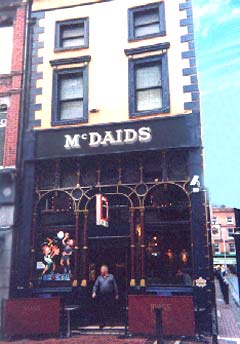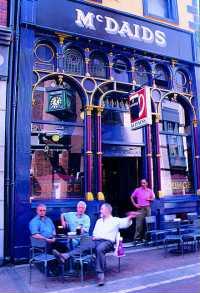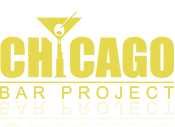Dublin 2
+353 (1) 679-4395
 In the entire Republic of Ireland, and especially in Dublin, it is not difficult to find pubs rich in character and history. Even so, the pub known simply as “McDaids” stands on its own as one of Dublin’s most colorful pubs, both literally and figuratively, having once been a favored meeting place for cutting-edge Irish writers. Today, McDaids attracts scores of tourists looking to feel part of Dublin’s literary legacy and nearby college students.
In the entire Republic of Ireland, and especially in Dublin, it is not difficult to find pubs rich in character and history. Even so, the pub known simply as “McDaids” stands on its own as one of Dublin’s most colorful pubs, both literally and figuratively, having once been a favored meeting place for cutting-edge Irish writers. Today, McDaids attracts scores of tourists looking to feel part of Dublin’s literary legacy and nearby college students.
Dating back to three years after the United States became a country, McDaids is one of Dublin’s oldest pubs. However, it is not the oldest. That title belongs to the Brazen Head, which dates back to 1198 and whose present location opened in the 1750’s. McDaids’ current location is at the corner of Harry and William Streets, next to the Westbury Hotel and across from the Bruxelles pub. Harry Street itself is just off the busy pedestrian mall known as Grafton Street – reminiscent of Chicago’s State Street when it was closed to traffic in the 1980’s. McDaids has been located on Harry Street for the past 120 years and, prior to that, was located a few minute’s away on Chatham Street. Before housing McDaids, the building served separately as a morgue and a Moravian chapel. How many pubs can say that? Today, McDaids can be easily spotted with its bright green, Victorian facade with yellow trim, along with its small, red Guinness mug sign, and its green Marshall Field’s-like clock. McDaids’ facade is complimented by a second and third stories painted in bright yellow and trimmed in green.
Step inside McDaids, through a smattering of plastic tables and chairs in its beer garden in summertime, and you will find a weathered, art deco interior with a Bohemian air. On the right-hand side of the room stands a decent-sized bar. Small wooden tables and plush chairs are scattered around the room. The room itself is quite notable for its very high ceiling that seems twice as high as the room is narrow. Pictures of Dublin scenery and literati adorn these high mahogany, wood-paneled walls, as well as shelves that hold old cigar boxes. The overall feel of the place is, “Not so much old style as real old,” according to the now-defunct Dublin Pubs.net.
 A long carpeted staircase with old-fashioned wallpaper at the end of the room leads up to the bathrooms and the bar on the second floor. There you will find several worn wooden tables, a large wooden bar, high wooden shelving upstairs with the usual array of kickshaws, and frosted glass windows. When it’s open to the public, the tables are filled making this plain, open area standing-room only. On other nights, the space serves as a party room for private functions.
A long carpeted staircase with old-fashioned wallpaper at the end of the room leads up to the bathrooms and the bar on the second floor. There you will find several worn wooden tables, a large wooden bar, high wooden shelving upstairs with the usual array of kickshaws, and frosted glass windows. When it’s open to the public, the tables are filled making this plain, open area standing-room only. On other nights, the space serves as a party room for private functions.
McDaids is often crowded, no matter what time of day or year, with local students from nearby Trinity college and tourists from America, Europe and all over the world. This creates an interesting mix as Irish lads pounce on unsuspecting foreign women, taking full advantage of their accents just like they do at Cullen’s here in Chicago. I once visited McDaids on a Saturday night and observed a very drunken, blonde, Scandinavian-looking girl literally surrounded by half a dozen Irish lads. She had the expression of a deer caught in the headlights and seemed to be easy pickin’s.
Part of the allure of the pub, and the subsequent interest by young local lads, is that McDaids was once the hub of mid-Nineteenth Century Irish literature. Here, in the 1940s and 50’s, McDaids was the local of the playwright, autobiographical novelist, and debaucherous Brendan Behan. Some say the characters in his novels The Hostage and Borstal Boy may have been based on other patrons at McDaids. Ulick O’Connor, in his book Brendan Behan, notes about the period immediately following World War II, “Now the younger writers tended to meet in pubs and, in reaction perhaps against the mild dandyism of the drawing-room scene of the decades before, they tended to pay less attention to their personal appearances. The London literary pubs of Soho and Fitzrovia had their counterparts in Dublin in the ‘forties. The sawdust floor and unpainted walls, the slight smell of unwashed bodies in McDaid’s in Harry Street—this was the new Bohemia’s answer to the Salon… Next door to Nisbet’s was McDaid’s Pub, where the group gathered for their drinking and where the publican was known as ‘Mr Er’, because of his inability to remember an customer’s name.” An additional insight into Brendan Behan in these times can be found in L.T. Jordan’s Balls of Malta, written in 1987.
 As indicated by Ulick’s comments, McDaids also attracted novelist James Joyce, poet Patrick Kavanagh, novelist Flann O’Brien (a.k.a. Brian O’Nolan), J.P. Donleavy, Liam O’Flaherty, and a number of other lesser known writers as regulars. Brendan Behan was not the only writer to be inspired by McDaids patrons. J.P. Donleavy’s central character in The Ginger Man is said to have been based on McDaids regular Gainor Christ. Around this time, Paddy O’Brien pulled pints at McDaids and was regarded as one of the best bartenders in Dublin, before he moved on to Grogan’s Pub when McDaids was sold in 1972. There, according to the defunct Grogan’s Pub website, many of McDaids’ regulars with the “gift of the gab” followed O’Brien and Grogan’s Pub took over the helm of Dublin’s literary avant-garde.
As indicated by Ulick’s comments, McDaids also attracted novelist James Joyce, poet Patrick Kavanagh, novelist Flann O’Brien (a.k.a. Brian O’Nolan), J.P. Donleavy, Liam O’Flaherty, and a number of other lesser known writers as regulars. Brendan Behan was not the only writer to be inspired by McDaids patrons. J.P. Donleavy’s central character in The Ginger Man is said to have been based on McDaids regular Gainor Christ. Around this time, Paddy O’Brien pulled pints at McDaids and was regarded as one of the best bartenders in Dublin, before he moved on to Grogan’s Pub when McDaids was sold in 1972. There, according to the defunct Grogan’s Pub website, many of McDaids’ regulars with the “gift of the gab” followed O’Brien and Grogan’s Pub took over the helm of Dublin’s literary avant-garde.
While these writers have moved on, McDaids remains a sought-after destination for locals and tourists alike, particularly in summer months when they host traditional Irish music at night. Since Ireland has flourished in the 1990’s with its Celtic Tiger economy, many pubs have opened up to grab their fare share of the market with a fabricated Irish pub atmosphere, just as they have here in Chicago. McDaids outdoes these newcomers along with many others because its history is real and its aged atmosphere is truly, authentically Irish.
For more information on Brendan Behan, be sure to check out Willy Wilson’s superb website on Brendan Behan.
“Work is the curse of the drinking class.”
– Oscar Wilde
